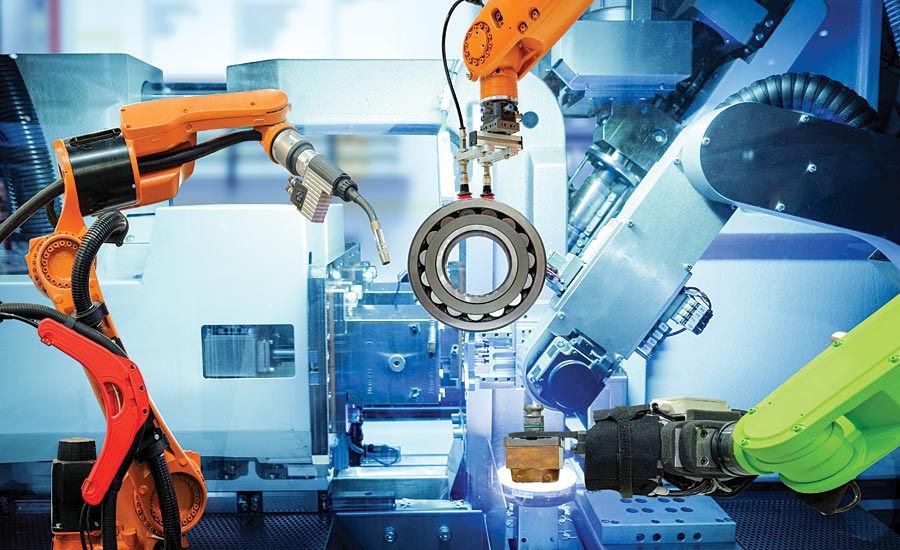1. Increased Use of Autonomous Mobile Robots in Manufacturing and Logistics
Autonomous Mobile Robots (AMRs) are the latest innovation that have been transforming traditional robot tasks through increased flexibility and diversified applications, including their unique ability to navigate in an uncontrolled environment with a higher level of understanding. Companies in every industry are investigating how AMRs can help them, as evidenced by the sold-out Autonomous Mobile Robot Conference our trade association sponsored in 2019 in Louisville, KY. Our next event will be on June 9, 2020, in Boston.
As ecommerce expands, there’s a greater need for rapid fulfillment. It’s hard for companies like Amazon and Walmart to hire enough people to ensure consumers get their products on time, especially during the holiday season. The growing demand can’t be met without automating. AMRs also keep the supply chain moving faster in manufacturing facilities, and are playing an increasing role in retail environments for tasks like shelf scanning and floor cleaning.
The Robotic Industries Association (RIA) is developing a new standard to address all aspects related to the safety of people around AMRs: the R15.08 American National Standard for Industrial Mobile Robots and Robot Systems – Safety Requirements, to be released in 2020.
2. Expanded Use of Machine Vision
Traditionally, machine vision was thought of as primarily a technology for tasks like inspection and identification. However, vision now plays an expanding role in all fields, enabling all sorts of interesting new applications.
Embedded vision is bringing a whole new range of capabilities to existing products, combining both image capture and image processing into one device. Embedded systems are lightweight, consume lower amounts of energy, feature lean designs, and create opportunities for new functionality, making them perfect for integration with existing systems, as well as products such as mobile phones and computers.
In heavy manufacturing operations, VEO Robotics is attempting to use machine vision to allow millions of industrial robots that are currently fenced off in factories to work safely around people.
Vision also is enabling advances in driverless cars, drones, and even in shopping, with the advent of stores like Amazon Go.
3. New Applications for Robotics Enabled by AI
Solutions leveraging the power of artificial intelligence (AI) are already paying off in automation and manufacturing. AI—in many shapes and forms—will be the stitching that weaves together a new age of industry. We expect to see many advances in the year ahead, especially related to robotics.
Machine learning software can help robotic systems adapt to their work environments, rather than designing every aspect of the environment and processes to suit the limitations of the machines. These advances will enhance both productivity and safety, and lead to more applications involving true collaboration between humans and robots.
With more and more connected systems featuring advanced sensor technology, AI can identify patterns in the data that are associated with breakdowns and other mechanical issues. This data will drive predictive applications, where AI can detect patterns that indicate a robot needs maintenance soon. It can automatically alert engineers to take necessary steps towards repairing a machine before it breaks down, saving companies costly downtime. AI-powered analysis of this data could also help businesses optimize their processes to improve quality and reduce waste.
We also see machine learning being used by robots to teach themselves how to perform tasks more successfully. Ultimately these advances will lead to robots sharing that knowledge via the cloud, allowing robots to learn from each other, which will improve the effectiveness of robot technology and speed deployment.

4. Grasping Advances
End effectors are the ultimate touchpoint for every product or part that goes out the door. Hardware and software advances enable safer, closer human-robot collaboration, ease of use, and flexibility for handling a wide variety of shapes and sizes.
To date, the challenge has been developing gripping solutions that are fast, don’t require lots of training, and can be used on any product, even ones the robot hasn’t seen before. Great progress is being made in this area, in part due to the advances in machine vision and AI discussed earlier.
Improvements in gripping enable robots to handle products of all kinds, including frozen bakery items, fruits and vegetables, and parts for consumer electronics, just to name a few. This leads to the use of robots in areas they’ve rarely or never been used before, such as food processing, agriculture, mobile manipulation in warehouses, and ultimately, in our homes, perhaps.
5. Continued Growth of Collaborative Robot Applications
Collaborative robot applications are gaining in popularity, and are often the entry point for new robotics users. Collaborative applications are encouraging more small and medium sized companies to automate—companies who have never automated before and see these specialized applications as an opportunity.
From small job shops to major aerospace companies, new uses for collaborative robots are popping up. These robots hold the promise of being easy-to-use, quick to set up and deploy, low cost, and safe for people to work around (meaning less floor space is needed and reduced investment in systems integration and safeguarding).
While it’s often the case that speed, payload, and other issues lead users to choose a more traditional robot application, the fact is collaborative robot applications have been disruptive to the industry and likely will continue to be going forward. According to the International Federation of Robotics (IFR), collaborative robots make up just 3% of the current installed robot base around the world, but are likely the fastest growing segment of new robot sales.






